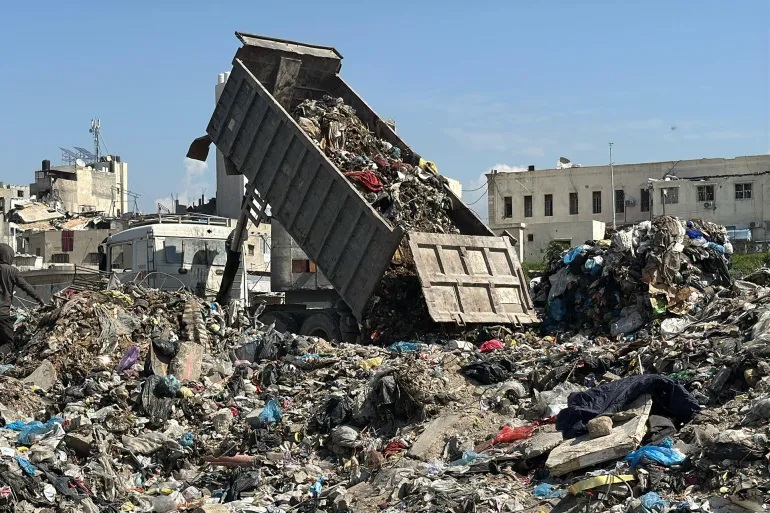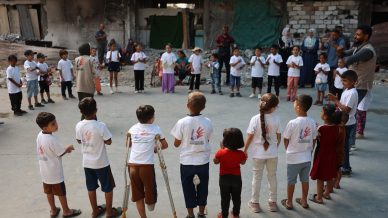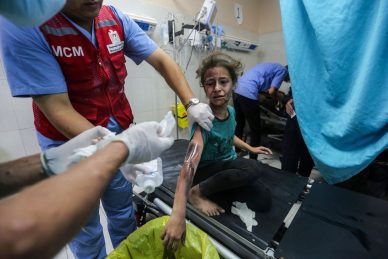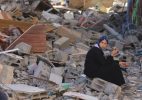GAZA, (PIC)
Displaced people in the Mawasi area of Khan Yunis, in the south of the Gaza Strip, are suffering from extremely dire health conditions due to piles of waste accumulating every few meters.
Um Yasser Dawoud, who lives in one of the tents there, is an asthma patient. Her health condition has worsened due to the stench of waste and sewage that blows in with every gust of air.
She says, “This place has become a source of diseases. Stray dogs gather at night and bark loudly, terrifying the children. Mosquitoes and flies never leave our tents either.”
What makes matters worse is the disposal of many dead animal carcasses in the same dumps, due to the difficulty of burying them amid the harsh conditions in the Gaza Strip and the ongoing Israeli bombardment across all areas.
Um Yasser continues, “This increases the foul odors and spreads diseases because of the worms coming out of them and the insects infesting the area.”
Bites and skin irritations
Mohammed Abu Dan, a resident of Al-Saha area in central Gaza City, shares how the random waste dumps have caused his four-month-old infant daughter to develop skin problems due to constant mosquito and fly bites.
He says, “My daughter’s body is covered in tiny blisters, and her skin is irritated because of the insects that never leave my house. I tried using primitive methods since there are no pesticides or fumigation tools, but all attempts failed.”
During a medical checkup, the doctor asked Mohammed about the nature of the place he lived in. He explained that he lives in a partially destroyed ground-floor apartment, just a few meters away from a waste dump recently created by residents, due to the inability of Gaza Municipality to transport the waste to its main safe dumps.
According to Sam Rose, Director of Planning at the United Nations Relief and Works Agency (UNRWA), people are living around “a volcano of grey and brown waste sediments” because they have no other choice.” He added, “People are literally living amid waste. Mass displacement has burdened everyone.”
UNRWA had previously confirmed that the accumulation of waste in the Gaza Strip poses a threat to people’s health and lives. In a post on the platform “X” on March 28, UNRWA said that many people are forced to live in tents amid piles of garbage.
The UN agency emphasized that the worsening waste crisis increases environmental and health challenges, and that Palestinians’ struggle to survive under severe humanitarian conditions has become increasingly difficult.
The Union of Gaza Strip Municipalities warned of the continued humanitarian catastrophe affecting the residents of the Strip due to the war of extermination. It confirmed that municipalities are unable to respond effectively because of a lack of equipment and essential resources amid massive destruction to infrastructure, and to service, environmental, and health sectors.
In a recent statement, the union called for urgent action to provide municipalities with their basic needs so they can fulfill their role in serving the public and alleviating the growing suffering. It also stressed the need to supply the necessary machinery and heavy equipment to handle approximately 55 million tons of rubble scattered across all governorates of the Gaza Strip.
A life-threatening environment
Gaza Municipality warns of an unprecedented health and environmental disaster threatening the lives of the city’s residents due to the accumulation of waste, sewage leaks, and the decomposition of victims’ bodies.
Municipal spokesperson Hosni Mehanna said the city is suffering from the accumulation of more than 175,000 tons of solid waste in its streets because the occupation forces are preventing municipal teams from accessing the main Juhor ad-Dik waste dump, east of the city.
In remarks to Anadolu Agency, Mehanna added, “The municipality’s efforts to overcome the crisis in cooperation with international organizations are facing major obstacles due to Israel’s refusal to allow in new equipment or permit teams to access the main dump site.”
He warned of the spread of diseases and epidemics “due to the accumulation of waste in Gaza’s streets and sewage leakage caused by the extensive destruction of infrastructure — not to mention the decomposition of bodies under the rubble.”
Mehanna stressed that these combined factors have created a favorable environment for the spread of insects and rodents in the city, especially with a shortage of materials needed to eliminate them.
A reflection of a broader crisis
The United Nations Development Program (UNDP) issued a similar warning, saying that the issue of solid waste management in Gaza has become an urgent need, requiring immediate support and solutions. The program noted that the waste crisis reflects the broader humanitarian crisis in the Gaza Strip even before the war.
Before the war began on October 7, 2023, the program had outlined a comprehensive roadmap for sustainable waste management in Gaza, focusing on transitioning to a circular economy model. However, since the outbreak of the war, priorities have shifted toward urgent humanitarian aid.
According to the program, the number of solid waste collection vehicles in Gaza decreased from 112 to 73 between 2017 and 2022. Most of these vehicles are old and insufficient, with each collection vehicle now serving 21,000 people, and each sanitation worker serving 3,343 people.
Toxic chemical substances
Environmental expert Dr. Nizar Al-Wahidi estimates that each person in Gaza produces about half a kilogram of solid waste per day, meaning the Strip disposes of around 1.2 million kilograms of waste daily.
In an interview with Al Jazeera Net, Al-Wahidi warned of the spread of random dumps among tents and homes, which threatens to cause severe skin and respiratory diseases. These areas are becoming breeding grounds for rats, large rodents, snakes, and disease-carrying insects. On top of that, the rotting waste emits foul odors and releases harmful, flammable gases.
He said, “Fifty million cubic meters of sewage per day cannot reach treatment plants because the occupation has destroyed the infrastructure. This has caused sewage floods in the streets, turning them into health hazards and dangerous swamps.” He also mentioned that Israel recently cut the only power line feeding the water treatment plant in Deir al-Balah in the center of the Gaza Strip.
The environmental expert expressed deep concern that this waste has become a mixture of organic waste, metals, dust, and debris from destroyed homes. “This means it may contain toxic and hazardous chemical substances, especially if the leachate from the waste seeps into the groundwater reservoir.”
Al-Wahidi stressed the urgent need to bury the waste safely and in accordance with internationally approved methods in the Gaza Strip. “Drinking water, which is the pillar of life for the people of the Gaza Strip and is now consumed without treatment, will become a deadly poison if this happens.”















